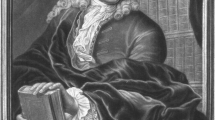Abstract
Wuerzburg in the centre of Germany claims to be a cradle of modern orthopaedics. Under the leadership of Johann Georg Heine (1771–1831) the first German orthopaedic hospital, the Carolinum, was established in 1816. Johann Georg Heine’s legacy was continued by his son Joseph (1803–1877) and his nephew Bernhard Heine (1800–1846), before Albert Hoffa (1859–1907) put the clinical practice of orthopaedics on a strict scientific basis and further promoted a worldwide exchange of knowledge. In 1916, Albert Hoffa’s successor Jakob Riedinger (1861–1917) founded the Koenig-Ludwig-Haus, which hosts the Orthopaedic Hospital and the Centre for Musculoskeletal Research of the University of Wuerzburg. On the occasion of the bicentenary and centenary anniversaries of the founding of the two orthopaedic hospitals, we provide a short view on the development of orthopaedics in Wuerzburg.








Similar content being viewed by others
References
Nerlich AG, Zink A, Szeimies U, Hagedorn HG (2000) Ancient Egyptian prosthesis of the big toe. Lancet Lond Engl 356:2176–2179. doi:10.1016/S0140-6736(00)03507-8
Kleisiaris CF, Sfakianakis C, Papathanasiou IV (2014) Health care practices in ancient Greece: the Hippocratic ideal. J Med Ethics Hist Med 7:6
Hajar R (2012) The air of history: early medicine to Galen (part I). Heart Views 13:120–128. doi:10.4103/1995-705X.102164
Hernigou P (2013) Ambroise Paré’s life (1510–1590): part I. Int Orthop 37:543–547. doi:10.1007/s00264-013-1797-5
O’Malley CD (1964) Andreas Vesalius 1514–1564: in memoriam. Med Hist 8:299–308
Hernigou P (2013) Ambroise Paré II: Paré’s contributions to amputation and ligature. Int Orthop 37:769–772. doi:10.1007/s00264-013-1857-x
Kohler R (2010) Nicolas Andry de Bois-Regard (Lyon 1658-Paris 1742): the inventor of the word “orthopaedics” and the father of parasitology. J Child Orthop 4:349–355. doi:10.1007/s11832-010-0255-9
Di Matteo B, Tarabella V, Filardo G et al (2013) The “GENESIS” of modern orthopaedics: portraits of three illustrious pioneers. Int Orthop 37:1613–1618. doi:10.1007/s00264-013-1936-z
Vollmuth R, Keil G (2003) Steadiness and progress. Medicine in Wuerzburg in the mirror of the centuries—a contribution to the foundation of the University of Würzburg 600 years ago [Article in German]. Wurzbg Medizinhist Mitt 22:7–20
Ruett A, Kuesswetter W (1983) Der Ursprung der deutschen Orthopädie in Wuerzburg und ihre Entwicklung zur selbständigen medizinischen Disziplin [Article in German]. Wurzbg Medizinhist Mitt 1:107–122
Hernigou P (2016) Fathers of orthopaedics in Germany (eighteenth and early nineteenth centuries): Lorenz Heister in Helmsted; Johann Friedrich Dieffenbach in Berlin; Heine and family in Würzburg. Int Orthop 40:425–431. doi:10.1007/s00264-015-2955-8
Horstmann DM (1985) The poliomyelitis story: a scientific hegira. Yale J Biol Med 58:79–90
Seffert S (1985) The significance of the scientist Prof. Bernhard Heine (1800–1846) for his age, especially for German and French orthopedics [Article in German]. Z Orthop Ihre Grenzgeb 123:89–93. doi:10.1055/s-2008-1045115
Heyde C-E, Zajonz D (2015) Aus der Geschichte der Leipziger Universitaetsorthopaedie [Article in German]. Aerzteblatt Sachsen 10:437–441
Hernigou P (2016) Authorities and foundation of the orthopaedic school in Germany in the 19th century: part II: Richard von Volkmann, Julius Wolff, Albert Hoffa, Friedrich Trendelenburg and other German authors. Int Orthop 40:843-853
Cannon AH (1959) Wilhelm Conrad Roentgen. Q Bull Northwest Univ Evanst Ill Med Sch 33:146–151
Ruett A, Kuesswetter W (1982) 150 Jahre Lehre der Orthopaedie an der Universitaet Wuerzburg. In: Baumgart P (ed) Vierhundert Jahre Universität Würzburg—Eine Festschrift [Book in German]. Degener, Bad Neustadt (Aisch), pp 841–870
Author information
Authors and Affiliations
Corresponding author
Rights and permissions
About this article
Cite this article
Jakuscheit, A., Rudert, M. Two hundred years of orthopaedics in Wuerzburg—one hundred years of the Koenig-Ludwig-Haus. International Orthopaedics (SICOT) 40, 1781–1785 (2016). https://doi.org/10.1007/s00264-016-3237-9
Received:
Accepted:
Published:
Issue Date:
DOI: https://doi.org/10.1007/s00264-016-3237-9




